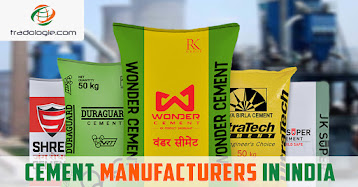Cement variety, development and trade status in India
Cement industry growth is proportional to the economy of a country. A booming economy leads to a higher level of construction activity. Cement is an important component while undertaking a construction task. It provides the necessary strength to the building structures. India is the second- largest producer of cement in the world. As of the year 2019, the country accounted for over 8% of the global installed capacity. Cement production has reached a mammoth 329 million tons in FY 2020. It is expected to grow further to 381 million tons in FY 2022. India’s cement industry is primarily dominated by a few companies. In fact, the top 20 company accounts for almost 70% of total cement production in the country. 210 large cement plants account for an installed capacity of over 410 million tons. Majority of the large cement plants are located in the state of Rajasthan, Andhra Pradesh and Tamil Nadu. Cement sale in India is approximated at ₹58, 407 crores in FY2020. Cement manufacturing in India has come a long way indeed since the industry was deregulated in 1982.
Marketing strategies and techniques employed for the production of cement have evolved over the years. Big players have changed the way to connect with customers. Traditionally, while connecting with customers, the focus was on functional benefits to educate customers. However, the advent of technology has made modern customers better aware of global development. Advertisers of the cement industry have been coming up with new ideas to impress the customers in a sensory overload world. Emotional connection is more important to customers in the modern marketing field. The purchasing decision is significantly impacted by the underlying sentimental tone in the delivery of the message.
Demand for cement showed a decline in the first half of the fiscal year 2019. This was the result of lower demand from the govt. end. The Government alone accounts for about 40% of the demand. The subdued demand also has been the result of a slowdown in the real-estate business. The real-estate industry had been severely impacted in the last few years due to liquidity crunch, labor shortage, shortage of finance, weak project execution and less availability of sand & water. Natural phenomena like a storm and excessive rainfall also played the spoilsport. The good news came in the second half with the government releasing funds for institutional projects. The industry started witnessing greater revenue and profits because of low raw material costs, falling commodity prices and reduces power & fuel costs.
Improvement in technology has ensured that the carbon footprint of the Indian cement industry has been falling over the last decade. To the credit, the cement industry in India has already accomplished a remarkable feat in reducing the carbon footprint. CO₂ emission has been reduced to an industry average of 0.72 t CO2/t cement from a substantially higher level of 1.12 t CO2/t cement in 1996. The target is to reduce it to a level of 0.58 t CO2/t of cement by 2050. For many years, NCB has been closely associated with Indian industry members of the Global Cement Sustainability Initiative (CSI), to find out new opportunities for carbon emission reduction and improved efficiency of the cement manufacturing process.
In the last few years, 60-70% of cement production in India has been in the form of blended cement mixing fly ash and granulated blast furnace slag. On average, the cement industry consumes approximately 57 million of fly ash. The generation of fly ash is expected to increase in the coming years. Besides, research and innovation are being done to enhance utilization of the flying ash. NCB has also been exploring the feasibility of using wastage from different industries like waste-E-cat, marble dust, granulated steel slag, etc. as raw materials for in cement manufacturing and blended components.
Bulk trading of cement has been made possible with the advent of technological trade platforms. Buyers and sellers can conduct business from the comfort of homes and offices. Platforms facilitating trade are aplenty but not reliable. TRADOLOGIE is a next-generation, trade enabler, B2B platform that connects buyers and sellers directly. Its innovative concept of reverse bidding has shifted the paradigm of trading business. The concepts ensure that only buyers and sellers receive the value out of a transaction. New buyers looking for bulk trading of cement may face many issues at the start. The paperwork and confusion of dealing with middlemen and intermediaries might prove too much. Buyers may postpone or abandoned the plan completely. The best way to procure directly from Soybean Oil Manufacturers & Suppliers is using a high-tech trade-enabler platform like TRADOLOGIE. As a matter of fact, buyers can save up to 20% in a B2B bulk marketplace like TRADOLOGIE. It also ensures that payment is secured for both parties. Transparency is the key to a business transaction. TRADOLOGIE just ensures that.
For more information about buying/selling cement online, visit our web-portal:
https://www.tradologie.com/lp/cement.html




Comments
Post a Comment